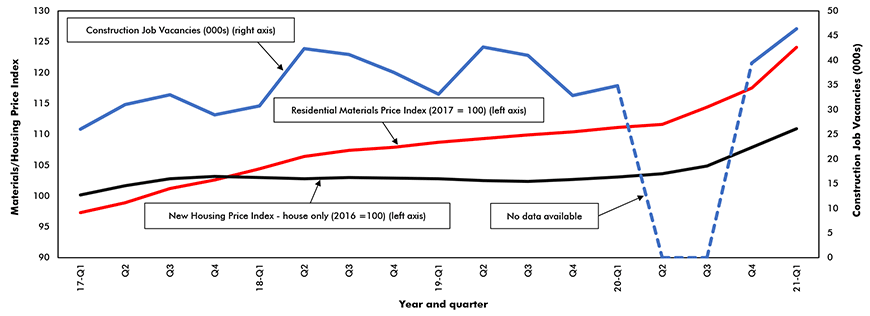Cost Awareness in Building
- February 23, 2022
Top Hidden Building Costs
We all know that material availability has been unpredictable and volatile, and that costs have been on the rise significantly—and that’s not going anywhere anytime soon.
But apart from material costs, what are some of the top hidden costs that are often overlooked during the building process?
Let’s take a look at a few, as well as how sustainable building solutions can address them.
The Hidden Costs
Labour Shortages
Labour shortages lead to delays; and the longer a project takes, the more it costs.
As we pass the two-year mark of the pandemic, not only do construction firms continue to be impacted by pandemic-induced supply chain disruptions and project delays, 89% of contractors are having a hard time finding craft workers.
According to Ken Simonson, chief economist of The Associated General Contractors
(AGC) of America, Inc. “The pandemic—and political responses to it—are limiting the size of the workforce, leading to labour shortages that are as severe as they were in 2019 when demand for construction was more robust.”
The two main reasons why so many firms are having trouble finding workers? 72% say available candidates are not qualified to work in the industry, and 58% report that unemployment insurance supplements are keeping workers away.
And this labour shortage is having significant consequences. According to ConstructConnect Canada, the:
- Unprecedented increase in the price of lumber and other sawmill products +
- The growing shortage of skilled labour +
- A countrywide decline in the inventory of available dwellings = The new house price index is up +12.9% y/y—a 15-year high.

Via ConstructConnect
Insurance and Replacement Costs
Canadian Underwriter reports that home insurance policyholders can expect an average 5% rate increase in 2022. Why? Rebuilds, renovations, and climate change are all to blame.
Rebuilds
Increases in building material costs have driven up insurance rates, and insurance rebuilds are often more expensive than construction costs arranged through private contractors. In addition to materials costs, other factors that affect home insurance premiums include the postal code, crime rates, and age of the home.
Renovations
With people at home during the pandemic, many finally did those home renovations—or created some out of boredom or due to new needs (home office, anyone?). But renovations increase the cost of rebuilding, which in turn drives up premiums. From January to November 2021 alone, 212,523 Canadians applied for residential alteration and improvements permits.
Climate Change
Extreme weather caused by climate change has resulted in millions worth of insured damages which, in turn, increase insurance premiums. A few catastrophic weather events in 2021 alone worth noting include the flooding in British Columbia in November, which cost more than $450 million, and the tornadoes that tore through Barrie, Ontario in July, which cost $100 million in insured losses.
We’ll keep on saying it like we’ve been saying it: getting ahead of the need to refurnish, repair, or replace your home by building a home that has resiliency in mind from the start will help you get ahead of rising insurance costs and save you from the grief and logistical nightmare that occurs when a disaster comes knocking.
How Sustainable Building Solutions Can Address These Costs
Thankfully, not all the news is bad—sustainable building solutions can help address these hidden costs in a few ways.
Incentives
There are numerous incentives regarding tax rebates, mortgage insurance rebates, and government grants for building a green home. These are available from:
- Provincial and territorial governments,
- Select municipalities,
- Major electric and gas utilities
- Financial institutions
A breakdown per province and links to each province’s rebates can be found on Built Green Canada’s site.
You can also apply for the Canada Greener Homes Grant, which is offering 700,000 grants of up to $5,000 to help homeowners make energy efficient retrofits to their homes. And the perks don’t end there—the Canada Mortgage and Housing Corporation (CMHC) offers a premium refund of up to 25% on the CMHC mortgage loan insurance premium when you:
- Buy an existing home and make energy-saving renovations
- Buy or build an energy-efficient home
Cost Certainty
Sustainable, prefab solutions, like ZS2’s TechBoard™, TechPanel™, and TechBrick™, are fire-rated, non-toxic, low-carbon building materials, providing cost certainty, accelerated construction timelines, and lower building operating costs.
Low Labour Requirement
Prefab builds aren’t experiencing the skilled labour shortages and extended timelines that traditional construction builds are facing. Why? Because prefab solutions:
- Offer a predictable budget delivered when promised
- Eliminate coordination between trades
- Eradicate defects in the product before it gets on site
- Leverage tools and systems that allow for ordering and preplanning upfront
- Offer remote training in advance to ensure everyone is ready to get to work once onsite
- Have all components (frame, insulation, drywall, and lines for wiring and plumbing) built into one panel instead of being brought on site separately—meaning instead of three hours of work in the field, it’s already been completed in one hour at the factory
Leverage Non-Volatile Materials
Non-volatile materials, like our prefab solutions, offer the following benefits:
- 1-hour fire rating
- Non-combustible sheathing and cladding
- WUI Certified
- Impermeable to water
- Superior strength
- Maintains strength after submersion
- Mould, mildew, and fungus resistant
- R30 and R40 attainable with TechPanels
- Average of 50% reduction in energy consumption
- 1/3 the CO2 of traditional cement
- 85% reduction in transportation cost and volume
- 55% faster, meaning fewer emissions
This means that if a catastrophic event occurs—whether it’s a wildfire, flood, or extreme temperatures—your build is more protected than traditional construction.
What Now?
The time is now to explore sustainable, prefab alternatives so you can get ahead of any hidden costs and come out on top.
Learn how ZS2 does it and how we can help—whether you’re mid-design, building, or simply have questions!

